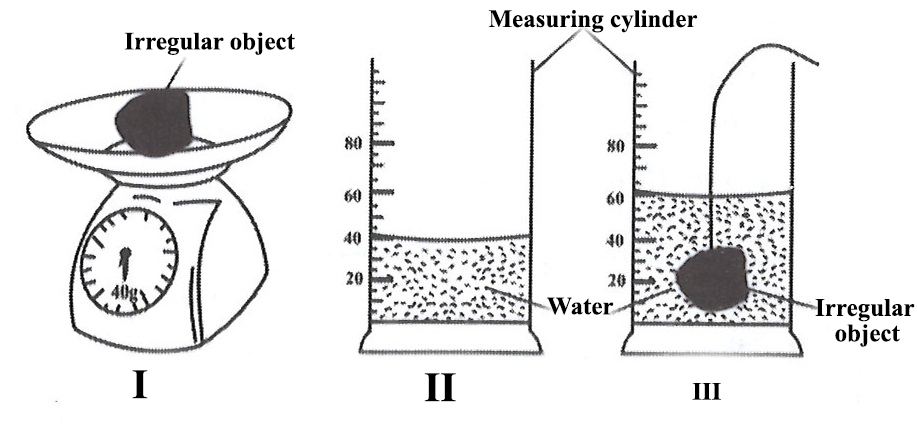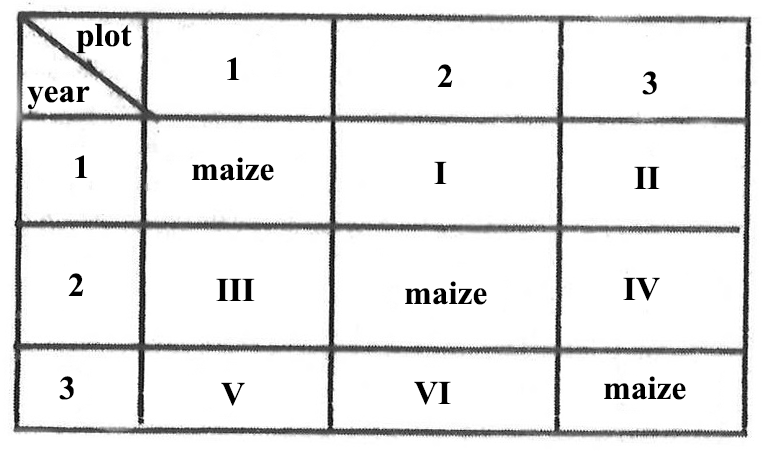1.
Which of the following parts of the tooth is embedded in the jaw bone?
Gum
Neck
Root
Crown
2.
Which part of the human body stores sperms temporarily?
Epididymis
Scrotum
Prostate gland
Sperm duct
3.
An advantage of soft water over hard water is that soft water
is good for formation of strong bones in humans
prevents heart diseases
has a pleasant smell
saves a lot of soap when used in washing
4.
The work done by force of 20 N on a body is 60 J. Calculate the distance through which the force moved
8.0 m
4.0 m
3.0 m
2.0 m
5.
Which of the following processes removes carbon from the atmosphere?
Respiration
Burning
Decomposition
Photosynthesis
6.
A substance which is made up of the same kind of atoms is called
a compound
an element
a mixture
an ion
7.
Which of the following statement(s) is/are true of a shadow? A shadow is formed
I. by a transparent object,
II. by an opaque object,
III. on a screen.
I only
II only
I and III only
II and III only
8.
Which of the following diseases results from malnutrition?
Scurvy
Measles
Malaria
Gonorrhoea
9.
The chemical formula of an aluminium sulphide is AlyS3.Determine the value of y
1
2
3
4
10.
Which of the following sources of energy is/are renewable?
I. Wind
II. Coal
III. Crude oil
I only
I and II only
II and III only
I,II and III
11.
Soils are describe as heavy because they
have high water holding capacity.
contain a lot of stones
have large air spaces
are difficult to till
12.
An example of a legume is
groundnut.
millet
sorghum
sweet potato
13.
The process used to separate a mixture of iron filings and sulphur is
magnetic attraction
sublimation
distillation
evaporation
14.
The colour of a soil profile determines the
depth at which implements are set
drainage ability of the soil
type of tool to use
15.
The end-product of digestion of fats and oils is
amino acid
glucose
maltose
fatty acid and glycerol
16.
The unit of potential difference
ampere
watt
ohm
volt
17.
A stone displaced 20 cm3 of water when immersed in the water. If the mass of the stone is 40 g. find the density of the stone
60 g cm-3
40 g cm-3
2 g cm-3
0.5 g cm-3
18.
One similarity of physical and chemical changes is that both
are easily reversible
result in change of state of matter
produce no change in mass
are accompanied by great heat change
19.
Which of the following elements is a macro-nutrient?
Copper
Manganese
Zinc
Sulphur
20.
The process by which metabolic wastes are removed from the body is called
respiration
excretion
egestion
21.
The part of the flower that produces pollen grains is the
stamen
filament
petal
anther
22.
Which of the following statement(s) about pressure in fluids is/are correct? Pressure
I. decreases with depth
II. increases with depth
III. does not depend on the area
I only
II only
I and II only
II and III only
23.
A boy who is seventeen years old is an
adult
adolescent
old person
infant
24.
The mode of heat transfer in which no material is involved is known as
conduction
convection
expansion
radiation
25.
Which of the following factors are used to describe a fertile soil?
I. Amount of organic matter
II. Color
III. Texture
I and II only
I only and III only
II and III only
I,II and III only
26.
The major charge carriers in p-type semiconductors are
anions
electrons
holes
neutral
27.
The dry season in Ghana is mainly from
January to March
April to June
July to September
October to December
28.
The practice that excess branches of growing plants are removed is termed
mulching
pruning
thinning
staking
29.
Which of the following soil type has the highest capillarity?
Clay
Loam
Sand
Silt
30.
Which of the following farming practices promote soil erosion
I. Alley cropping
II. Bush burning
III. Over grazing
I and II only
I and III only
II and III only
I, II and III
31.
The nearest planet to the sun in the solar system is
Earth
Mars
Mercury
Venus
32.
In which of the following devices is electrical energy transformed into light energy
Electric bell
Fluorescent tube
Lantern
Radio
33.
An example of a semi-metal is
silicon
carbon
beryllium
D. argon
34.
The elements in the periodic table are arranged according to their
atomic number
atomic mass
mass number
neutron number
35.
Which of the following states of matter are fluids
I. Solid
II. Liquid
III. Gas
I and II only
I and III only
II and III only
I, II and III
36.
A liquid-liquid mixture can be seperated by
filtration
evaporation
sublimation
distillation
37.
When an unknown solution reacted with magnesium, a gas was produced. Which of the following solutions could be the unknown solution
Sodium chloride solution
Sodium hydroxide solution
Hydrochloric acid
Calcium nitrate solution
38.
Which of the following statements about acids correct
I. They react with the calcium carbonate to give a gas
II. They turn red litmus paper blue
III. They react with reactive metals to give a gas
IV. They turn blue litmus paper red
I, II and IV only
I, II and III only
II, III and IV only
D. I, III and IV
39.
The structure which enables a fish to breate in water is
buccal cavity
gills
swim bladder
lungs
40.
A fruit in which the pappus has been modified into a parachute structure is dispersed by
explosion
mammals
water
wind
a)
The diagram below are illustrations of two cells labelled A and B
Study the diagram carefully and answer the questions that follow.

i)
Name each of the parts labelled I, II, III and IV.
ii)
Which of the parts named in (a)(i) is the same as the parts labelled VI and IX in cell B?
iii)
Which of the cells is a plant cell?
iv)
Give two reasons for the answer given in (a)(iii).
v)
Tabulate two differences between the parts labelled I and V.
b)
The diagram below is an illustration of an experiment carried out in the laboratory.
Study the diagram carefully and answer the questions that follow.

i)
Read and record the:
(α) mass of irregular object (M) in I
(β) Volume of water (V1) in II
(γ) Volume of water (V2) in III
ii)
Determine the volume of the irregular object.
iii)
Calculate the density of the irregular object.
iv)
Name the instrument that could be used to measure the mass of an irregular object.
v)
State one precaution to be taken in performing the experiment.
c)
The following activities were performed in the laboratory by groups of pupils.
Study the activities and answer the questions that follow.
i) Camphor was heated.
ii) Wood was burnt.
iii) Iron nails were heated strongly.
iv) Sodium chloride was dissolved in water.
i)
Which of the following activities are:
(α) chemical processes;
(β) physical processes.
ii)
Give two reasons why the activities listed in:
(α) (i)(α) are chemical processes;
(β) (i)(β) are physical processes.
iii)
Give two examples of physical change that take place in your environment.
d)
A farmer cultivated soya bean, yam and maize on a farm in a rotational programme as illustrated below.
Study the diagram carefully and answer the questions that follow.

i)
Copy and complete the table.
ii)
List three principles to consider when planning this rotational programme.
iii)
Give two reasons for selecting the crop named for V in plot 1 year 3.
iv)
State one advantage of practising this farming system.
a)
State three external features of the weaver birds that adapt to live successfully in its environment.
b)
List four harmful effects of air pollution.
c)
i)
Draw the magnetic lines of force around a bar magnet.
ii)
If the work input of a machine is 30 joules, what would be its efficiency when the work output is 25 joules?
d)
Outline three principles involved in vegetable crop production.
a)
i)
State two differences between an ecosystem and a habitat.
ii)
What is meant by the term blood?
b)
Explain why it is difficult to separate iron and sulphur mixture after strong heating.
c)
Draw and label a diagram of a ray of light which makes an angle of 350 with the surface of a plane mirror.
d)
State two
i)
advantages of a land rotation.
ii)
disadvantages of land rotation.
a)
State one symptoms each of the following infections diseases:
i)
cerebrospinal meningitis;
ii)
chicken pox;
iii)
typhoid.
b)
i)
What is energy?
ii)
Give two reasons why it is necessary to conserve energy.
c)
i)
State two methods of restoring soil resources.
ii)
Explain briefly one of the methods stated in (c)(i).
d)
i)
What is binary compound?
ii)
Write the chemical formula of the compound formed between:
(α) Oxygen and lithium
(β) Magnesium and Chlorine
iii)
Name the compound formed in (ii)(α)
a)
i)
State two uses of water in agriculture.
ii)
Name two crops that are deep rooted.
b)
i)
Explain the term circulatory system in humans.
ii)
Classify each of the following processes as diffusion or osmosis:
α)
absorption of water by the roots of a plant
β)
movement of digested food from the small intestine into the blood stream
c)
i)
What is mass?
ii)
A box of equal size 3cm has a density of 2.0gcm-3.What is its mass?
d)
Give the state of each of the following substances:
i)
ash;
ii)
carbon dioxide.
a)
State three functions of the female reproductive system in humans
b)
i)
What is the role of a capacitor in a circuit.
ii)
Give two examples of a compound machine
c)
i)
What is Integrated Pest Management?
ii)
State two advantages of practicing integrated pest management.
d)
i)
State two classes of mixtures.
ii)
Classify each of the following substances under the classes stated in (i)
(α) bronze;
(β) when perfume is sprayed into the air.